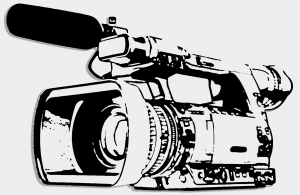The EHE EdTech Multimedia team has been hard at work updating their three studio spaces: The Commons Whisper Room, The EHE One Button Studio , and Studio 339 (housed in Ramseyer room 260, 360A, and 339 respectively). While the Whisper Room and One Button are fully operational, Studio 339 (pictured above) is currently undergoing major changes. The largest upgrade in this space, to date, is the brand new soundproof drop ceiling. Composed of Real Traps’ ceiling tiles, this ceiling will help improve the sound quality of our recordings tremendously by providing both base trapping, and sound reflection control. In addition we will soon be adding new carpeting, sound proofing curtains, wall traps, a motorized backdrop system, and many new pieces of equipment.
Above you will see Alex Everett, The EdTech Media Services’ Manger, and two of our Media Services’ student assistants, Nikolai Elencovf and Michael Garrett, testing out our new Cobra Crane. This relatively inexpensive jib is allowing us to get amazing, simultaneous pan and tilt shots, giving us the potential to gather a lot of engaging dynamic footage in our video production.
Stay tuned for more studio updates, and EHE EdTech news!
Helpful Links:
- Cobra Crane Setup Demo: (https://www.youtube.com/watch?v=8qievAVPmGc
- Real Traps’ ceiling tiles: http://realtraps.com/p_ceiling.htm).








 If you are an educator, you know that you should never get up in front of a class without first preparing a word-for-word script. You must make sure that everything in your lecture is grammatically correct, that the vocabulary is impressively academic, and that no detail is left unmentioned. You should spend as much time as it takes to memorize this presentation, because you know what messing up means! The class will expect you to start over again from the very beginning, and keep repeating this process until everything is absolutely perfect.
If you are an educator, you know that you should never get up in front of a class without first preparing a word-for-word script. You must make sure that everything in your lecture is grammatically correct, that the vocabulary is impressively academic, and that no detail is left unmentioned. You should spend as much time as it takes to memorize this presentation, because you know what messing up means! The class will expect you to start over again from the very beginning, and keep repeating this process until everything is absolutely perfect.
